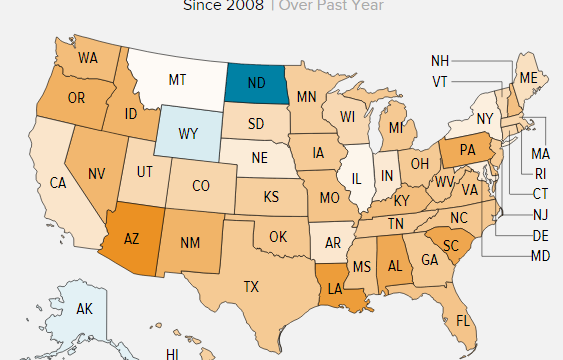North Dakota Proves You Can't Blame Tuition Hikes On State Funding

I woke up this morning to multiple emails from state lawmakers and SAB readers linking me to this Vox article about the relationship between state appropriations for higher education and tuition costs.
According to Vox, tuition hikes are a product of budget cuts for universities. “One reason student debt has skyrocketed is that public colleges and universities, which most students attend, were absolutely devastated by the recession,” writes Libby Nelson. “The Center on Budget and Policy Priorities put together this interactive map showing how much per-student funding has dropped and how much tuition has increased since 2008.”
You can see the map below.
The problem with the conclusion Vox is drawing from the map is that, well, the map doesn’t support their conclusions. And North Dakota proves it.
[mks_pullquote align=”right” width=”300″ size=”24″ bg_color=”#000000″ txt_color=”#ffffff”]Vox would have us believe that there is a cause-and-effect relationship between higher education budgets and tuition. But that’s not true. In fact, the larger story here is that there doesn’t seem to be any sort of a cause-and-effect relationship between the two.[/mks_pullquote]
As you can see, our state has led the nation in spending growth for higher education. The university budgets are up over 35 percent in inflation-controlled dollars from 2008 to 2015. No other state even comes close to North Dakota. The next biggest increase happened in Wyoming, which saw a more modest 5.4 percent increase in university spending.
Yet, North Dakota saw a 13.4 percent increase in tuition costs during that same time. That’s on par with, say, Maine which saw a 12.5 percent tuition hike despite a 13.4 percent decline in higher ed funding. Or Indiana where tuition is up nearly 15 percent while funding has decreased 9.5 percent.
Wyoming, also, saw a 14.5 percent tuition increase. Alaska, which increased higher education funding 3.9 percent, saw a 21.5 percent tuition increase.
During this time period tuition increased in every single state in the nation. In 49 states the increase was in double digits (Montana is the exception).
Vox concludes that there is a cause-and-effect relationship state appropriations for higher education and recent tuition increases. While I have no doubt that appropriations play a role in tuition decisions, it’s not the deciding factor as evidenced by the fact that even states which haven’t been cutting university budgets, which have in fact been increasing them, have seen tuition hikes.
And if you need more evidence, consider what happens when we zoom out on the timeline a bit. Paul Campos, writing for the New York Times, points out that tuition has grown aggressively right alongside higher education budgets:
In fact, public investment in higher education in America is vastly larger today, in inflation-adjusted dollars, than it was during the supposed golden age of public funding in the 1960s. Such spending has increased at a much faster rate than government spending in general. For example, the military’s budget is about 1.8 times higher today than it was in 1960, while legislative appropriations to higher education are more than 10 times higher. …
State appropriations reached a record inflation-adjusted high of $86.6 billion in 2009. They declined as a consequence of the Great Recession, but have since risen to $81 billion. And these totals do not include the enormous expansion of the federal Pell Grant program, which has grown, in today’s dollars, to $34.3 billion per year from $10.3 billion in 2000.
Yet no matter how much money universities get from taxpayers tuition grows. “[O]ver the past 35 years, college tuition at public universities has nearly quadrupled, to $9,139 in 2014 dollars,” Campos writes.
“If over the past three decades car prices had gone up as fast as tuition, the average new car would cost more than $80,000,” he adds.
Again, Vox would have us believe that there is a cause-and-effect relationship between higher education budgets and tuition. But that’s not true. In fact, the larger story here is that there doesn’t seem to be any sort of a cause-and-effect relationship between the two.
No matter how much money the universities get from taxpayers and students they always want more.





